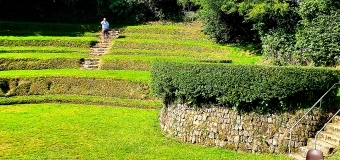Indian queens in the heart of Cornwall
DURING NUMEROUS VISITS to Cornwall, we have driven along the A30 road. Often on these journeys, we have driven past signs pointing to a place named ‘Indian Queens’, but we had never visited it. So, on the 29th of June 2024, we left the main road and headed towards Indian Queens without knowing what to expect. To be honest, at first sight, the place does not seem of any interest to the visitor. But, as we were to discover, Indian Queens contains one of the most unusual sights in Cornwall.
By chance, we pulled up opposite a house, which incorporates two granite pillars surmounted by a triangular pediment on which the following words are inscribed:
“THE INDIAN QUEEN. Licensed brewer and retailer of beer, cyder, spirits, wine, and tobacco. Licensed to the post horses.”
The building to which this was attached was not a pub and looked newer than the pillars and the inscribed pediment. These fragments are all that remains of a pub called ‘The Indian Queen’, which stood in another part of the district: between Goss Moor and Fraddon. The former pub, which had been built in the late 18th century, had a Victorian signboard (now in a museum in Truro). It depicted an American Indian Queen on one side and Queen Victoria on the other. Until about 1780, the pub had been called ‘The Queen’s Head’, but by 1787, it had become ‘The Indian Queen’. It is thought by some that a Portuguese princess, who was travelling between Falmouth and London, stayed at the inn, and because she was olive skinned, the locals thought she was an American Indian queen, and that is how the name of the pub and of the village originated. Later, the village name changed from Indian Queen to Indian Queens, as it is known today.
The village has one Indian restaurant, aptly named “Indian Queen”. Run by some friendly Bangladeshi people, it occupies what was formerly The Railway Tavern pub. We ate dinner there. The following morning, we returned to Indian Queens to look at something we had missed the day before. Pocohontas Crescent leads to a footpath that heads towards the Indian Queens Pit. This proved to be a most interesting place.

In 1850, local Wesleyans approached the mine owner Henry Jenkyn to convert the local, disused quarry into an outdoor ‘preaching pit’, like the one already created (from a disused mining quarry) at Gwennap near Redruth, which was used by John Wesley – the founder of Methodism. The preaching pits were like amphitheatres in which large numbers of people could listen to the preaching of Methodist ministers. By 1860, the pit at Indian Queens was already being used by the congregations of various local Methodist chapels. Between 1880 and 1907, the pit had been adapted to look as it does today. The sloping sides of the pit were remodelled to create tiers just like those in ancient Greek and Roman amphitheatres, but each row was separated by a much greater height than in the ancient versions. The circular tiers encircle a round, flat area below them. By 1907, the semicircular raised preaching platform was in place. The pit was used for preaching, Sunday School anniversaries, and other events until 1970.
Between 1970 and 1976, the pit became overgrown and was unused. However, in 1976, a local man, Lloyd Truscott, worked hard to restore the pit. On the 20th of May 1978, a service was conducted in the restored pit. Today, the pit is owned by a group of trustees representing the local Methodists and other organisations. It is still used for staging events, and we were lucky enough to attend one of them on the 30th of June 2024. That afternoon, we watched a highly entertaining improvised version of “Tristan and Isolde” – a play, not the opera. Three young actors performed it very engagingly and with great panache.
Until we ventured into Indian Queens, I had never heard of preaching pits. There are three surviving circular preaching pits in Cornwall, and one, which only occupies a quarter of a circle. I hope to write more on this subject at a later date.



